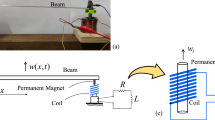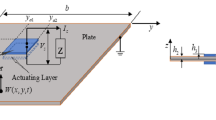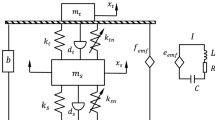Abstract
Electrodynamic actuators and electromagnetic dampers (EMD) are used extensively in mechanical systems. They utilise the electromagnetic induction concept to generate eddy current and Lorentz forces for providing vibration suppression forces. In this research, these principles will be developed for vibration serviceability control of a civil engineering structure.
An electrodynamic actuator is used in this research, together with a shunt resonant circuit, an RLC resonant circuit (a simple electronic circuit oscillator) which is needed to cascade with the EMD for closing the circuit and generating electrical damping forces. The EMD is set between the structure and the ground. The kinetic energy of the vibrating structure provides the input energy to activate the EMD.
H ∞ optimisation (minimisation of the maximum response) and H 2 optimisation (minimisation of kinetic energy) are used to obtain the vibration suppression performance, which is compared against a conventional tuned mass damper (TMD). The EMD with shunt resonant circuit (EMDS) can have similar dynamic performance, which achieves suppression of resonant vibration amplitude of the primary structure down to two lower amplitude peaks in the frequency domain. Hence, this work shows that the EMDS can in principle achieve satisfactory vibration suppression performance.
Access this chapter
Tax calculation will be finalised at checkout
Purchases are for personal use only
Similar content being viewed by others
References
Mizuno T, Toumiya T, Takasaki M (2002) Vibration isolation system using negative stiffness. JSME Int J 46:807–812
Fleming AJ, Moheimani SR, Member S (2006) Inertial vibration control using a shunted electromagnetic transducer. IEEE/ASME Trans Mechatron 11:84–92
Behrens S, Fleming A, Reza Moheimani S (2003) Electromagnetic shunt damping. In: Proceedings 2003 IEEE/ASME International Conference on Advanced Intelligent Mechatronics (AIM 2003), vol. 2, pp. 1145–1150
Marneffe BD (2007) Active and passive vibration isolation and damping via shunted transducers. Universite Libre de Bruxelles, Brussels
Fleming AJ, Hons BEE (2007) Synthesis and implementation of sensor-less shunt controllers for piezoelectric and electromagnetic vibration control. The University of Newcastle, Callaghan
Niu H, Zhang X, Xie S, Wang P (2009) A new electromagnetic shunt damping treatment and vibration control of beam structures. Smart Mater Struct 18:045009
Behrens S, Fleming AJ, Moheimani SR (2005) Passive vibration control via electromagnetic shunt damping. IEEE/ASME Trans Mechatron. 10:118–122
Inoue T, Ishida Y, Sumi M (2008) Vibration suppression using electromagnetic resonant shunt damper. J Vib Acoust 130:041003
McDaid AJ, Mace BR (2013) A self-tuning electromagnetic vibration absorber with adaptive shunt electronics. Smart Mater Struct 22:105013
Cheng TH, Oh IK (2009) Vibration suppression of flexible beam. IEEE Trans Magn 45:2758–2761
den Hartog J (1985) Mechanical vibrations. Dover, Mineola
Wong W, Cheung Y (2008) Optimal design of a damped dynamic vibration absorber for vibration control of structure excited by ground motion. Eng Struct 30:282–286
Cheung Y, Wong W (2011) H2 optimization of a non-traditional dynamic vibration absorber for vibration control of structures under random force excitation. J Sound Vib 330:1039–1044
Gradshteyn IS, Ryzhik IM (2007) Table of integrals, series, and products, 7th edn. The United States of America: Elsevier Academic Press, Boston
Acknowledgements
The authors would like to acknowledge the financial assistance provided by the UK Engineering and Physical Sciences Research Council (EPSRC) through a Leadership Fellowship Grant (Ref. EP/J004081/2) entitled “Advanced Technologies for Mitigation of Human-Induced Vibration”.
Author information
Authors and Affiliations
Corresponding author
Editor information
Editors and Affiliations
Rights and permissions
Copyright information
© 2015 The Society for Experimental Mechanics, Inc.
About this paper
Cite this paper
Ao, W.K., Reynolds, P. (2015). Analysis of H ∞ and H 2 Optimal Design Scheme for an Electromagnetic Damper with Shunt Resonant Circuit . In: Wicks, A. (eds) Shock & Vibration, Aircraft/Aerospace, and Energy Harvesting, Volume 9. Conference Proceedings of the Society for Experimental Mechanics Series. Springer, Cham. https://doi.org/10.1007/978-3-319-15233-2_21
Download citation
DOI: https://doi.org/10.1007/978-3-319-15233-2_21
Publisher Name: Springer, Cham
Print ISBN: 978-3-319-15232-5
Online ISBN: 978-3-319-15233-2
eBook Packages: EngineeringEngineering (R0)




